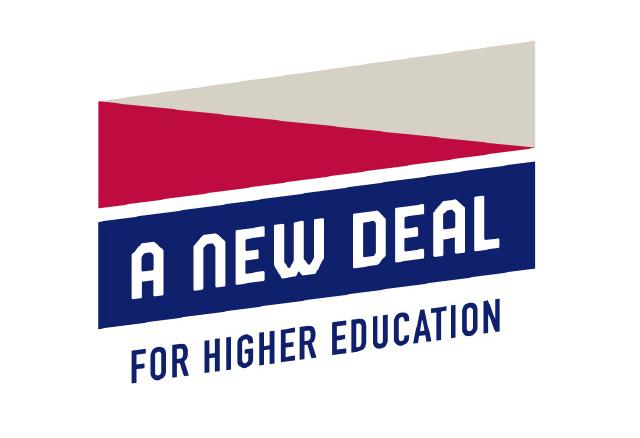While the COVID-19 pandemic has amplified longstanding societal inequities in America, public higher education was already in a state of crisis, from the staggering costs of college, to the lack of access and support for lower income students, Black, indigenous, and people of color, the deteriorating, or clear lack of infrastructure, the reciprocal increase in highly paid administrative positions, and last but not least, decrease in full-time tenure track positions. Nationwide, approximately three-quarters of higher ed faculty teach on an adjunct or contingent basis, and are compensated so poorly that, according to surveys by the AFT and the UC Berkeley Labor Center, approximately 25% are on some form of public assistance.
All of the above underscore the need for relief, reform, and recovery — the key components of AFT and AAUP’s recently launched “A New Deal for Higher Education,” in the inspiration of Franklin Delano Roosevelt’s New Deal that pulled the United States out of the Great Depression in the 1930s, and contingent faculty working conditions are a key component.
Stressing four major components being “building prosperity from the ground up, advancing social, racial, and economic justice, strengthening democracy and civil society and fostering knowledge and innovation,” the campaign, particularly with regard part-time faculty “spotlights reforms related to racial injustice and inequities, labor practices, academic freedom and governance, federal research funding, technical and vocational education, and a host of other challenges.”In terms of relief, the campaign calls for the cancellation of student debt. Many adjuncts, particularly those recently out of college with terminal degrees, shoulder over $100,000 in student debt, and repayment on the loans is a staggering task when one-third of adjunct faculty report making less than $25,000 a year, according to the AFT’s adjunct-contingent survey report, “An Army of Temps,” Further, the campaign calls for making public higher education tuition free, and the notion of “zero debt at graduation” a possibility.
As for reform, the New Deal for Higher Education calls for a reprioritization of spending, and adjuncts are in the mix. As noted in the Roosevelt Institute policy paper, “A True New Deal for Higher Education,” which serves as the campaign’s inspirational document, funding models based on tuition have lead to institutional spending on amenities like gyms, food courts, and dormitories in an effort to attract students, but at the expense of the college’s core mission. At the same time “many institutions also hired a large class of highly paid administrators instead of investing in faculty.”
Investing in faculty in large part means addressing the overuse of adjunct faculty. The Roosevelt report calls for “higher education institutions to have actionable plans to move contingent faculty to permanent positions” and to “pay family-sustaining wages.” It asks that state-level boards of higher education employers and workers, including faculty and graduate students, be brought together to negotiate operating practices and standard pay scales at a sector-wide level.
To further the campaign in California, delegates to CFT Convention on March 27 adopted the resolution, Rise Up, Recover, Rebuild: A New Deal for Higher Education. CFT Senior Vice President Lacy Barnes helped craft the resolution and sits on the steering committee for AFT’s New Deal campaign. She sees this pattern of adjunctification, coinciding with low pay and minimal to no benefits, as a form of faculty “de-professionalization.” Barnes, also co-chair of the AFT Program and Policy Council for Higher Education, says, “this is one of the legs of the stool,” when it comes to realizing a New Deal for Higher Education.
As for recovery, the New Deal for Higher Education calls not simply for an increase in funding, but to make it more stable and equitable. One of the main reasons that higher ed was already facing crisis conditions prior to the pandemic is the decades of progressive underfunding. Between 2008 and 2018, funding for public two- and four-year colleges dropped by $6.6 million. When it comes to equity, community colleges, that serve disproportionately larger numbers of Black and Latinx students, receive $78 billion less than the four-year schools, amounting to an average of $8,800 per student.
Inside Higher Ed reported in 2015 that approximately 80% of tuition hikes in public higher education were due to “declining state appropriations.” Further, in times of economic downturns when funding to public colleges is cut, it is also ironically when student enrollment, particularly in community colleges, increases.
The New Deal for Higher Education calls for an increase in federal funding “beyond student loans,” but at the same time does not allow for states to reduce their higher education spending. It calls for these funds to be equitably distributed to “disproportionate numbers of low-income, first-generation students, and Black and brown students should get funding at least on a par with similarly sized, wealthier institutions.” And calls for states to “adopt formulas to distribute funds that rebalance funding across their public higher education systems.” Finally, the New Deal calls for putting “our higher education system on more stable economic footing with funding streams that recognize the industry’s countercyclical nature.”
If realized, the New Deal for Higher Education could be the truly transformative. As AFT President Randi Weingarten has said, “We have a unique opportunity for our schools, colleges and students to thrive — and we need to seize it.”
— By Geoff Johnson, assigning editor of Part-Timer
newsletter, member of the CFT Part-Time Faculty Committee and the
AFT Guild, San Diego and Grossmont-Cuyamaca Community
Colleges




